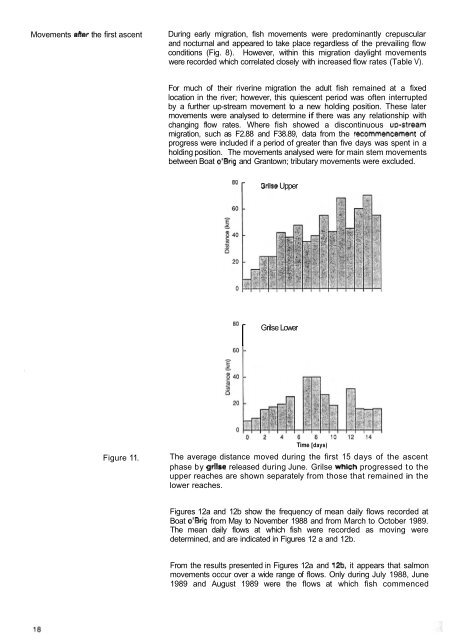( Salmo salar L.) in the River Spey as determined by
( Salmo salar L.) in the River Spey as determined by
( Salmo salar L.) in the River Spey as determined by
Create successful ePaper yourself
Turn your PDF publications into a flip-book with our unique Google optimized e-Paper software.
Movements after <strong>the</strong> first <strong>as</strong>cent<br />
Dur<strong>in</strong>g early migration, fish movements were predom<strong>in</strong>antly crepuscular<br />
and nocturnal and appeared to take place regardless of <strong>the</strong> prevail<strong>in</strong>g flow<br />
conditions (Fig. 8). However, with<strong>in</strong> this migration daylight movements<br />
were recorded which correlated closely with <strong>in</strong>cre<strong>as</strong>ed flow rates (Table V).<br />
For much of <strong>the</strong>ir river<strong>in</strong>e migration <strong>the</strong> adult fish rema<strong>in</strong>ed at a fixed<br />
location <strong>in</strong> <strong>the</strong> river; however, this quiescent period w<strong>as</strong> often <strong>in</strong>terrupted<br />
<strong>by</strong> a fur<strong>the</strong>r up-stream movement to a new hold<strong>in</strong>g position. These later<br />
movements were analysed to determ<strong>in</strong>e if <strong>the</strong>re w<strong>as</strong> any relationship with<br />
chang<strong>in</strong>g flow rates. Where fish showed a discont<strong>in</strong>uous up.stream<br />
migration, such <strong>as</strong> F2.88 and F38.89, data from <strong>the</strong> recommencement of<br />
progress were <strong>in</strong>cluded if a period of greater than five days w<strong>as</strong> spent <strong>in</strong> a<br />
hold<strong>in</strong>g position. The movements analysed were for ma<strong>in</strong> stem movements<br />
between Boat o'Brig and Grantown; tributary movements were excluded.<br />
r Grilse Upper<br />
[ Grilse Lower<br />
Figure 11.<br />
Time [days)<br />
The average distance moved dur<strong>in</strong>g <strong>the</strong> first 15 days of <strong>the</strong> <strong>as</strong>cent<br />
ph<strong>as</strong>e <strong>by</strong> grllse rele<strong>as</strong>ed dur<strong>in</strong>g June. Grilse which progressed to <strong>the</strong><br />
upper reaches are shown separately from those that rema<strong>in</strong>ed <strong>in</strong> <strong>the</strong><br />
lower reaches.<br />
Figures 12a and 12b show <strong>the</strong> frequency of mean daily flows recorded at<br />
Boat o'Brig from May to November 1988 and from March to October 1989.<br />
The mean daily flows at which fish were recorded <strong>as</strong> mov<strong>in</strong>g were<br />
determ<strong>in</strong>ed, and are <strong>in</strong>dicated <strong>in</strong> Figures 12 a and 12b.<br />
From <strong>the</strong> results presented <strong>in</strong> Figures 12a and 12b, it appears that salmon<br />
movements occur over a wide range of flows. Only dur<strong>in</strong>g July 1988, June<br />
1989 and August 1989 were <strong>the</strong> flows at which fish commenced
















